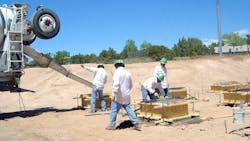For the past few months we have been looking at artificial intelligence (AI) as it goes mainstream. This controversial technology has been attracting both positive and negative responses, but like most innovative technologies, there are too many benefits to ignore. Like it or not, AI is here to stay. Our challenge will be utilizing AI safely because it’s improving the power grid, but I have a feeling that isn’t going to be easy.
Wouldn’t it be nice to get a break from all this abstractness and look at something that’s more tangible. How about something called “green concrete?” Concrete is an age-old technology whose history stretches back thousands of years. Some would argue that it hasn’t changed much in all that time, but is that true? In the modern world science is everywhere even when it comes to concrete. Surprisingly, high-tech concrete is becoming another tool in our battle against greenhouse gases.
As a substation engineer, I’ve installed a lot concrete in my career. We referred to the freshly poured concrete as being green. It simply meant the concrete had to cure before moving on to the next phase of construction, but that’s not the case now. Green concrete has taken on a totally different connotation. In today’s terminology means the concrete is eco-friendly or it’s a low-carbon concrete, which is hard to get my head around. Studies estimate that approximately 8% of all the world’s greenhouse gas emissions are generated by concrete manufacturing.
Concrete’s environmental problem starts with the cement used in the process of producing concrete. The cement is made by converting its primary ingredient, limestone, into calcium oxide. This is an energy-intensive process. In 2023, approximately 30 billion tons of concrete was used worldwide. The manufacturing of the cement for 30 billion tons of concrete released about 4 billion tons of carbon dioxide (CO2) into the atmosphere, which is a significant figure.
It's Not Easy Being Green
What started me on this train of thought was a simple press release. Well, actually two releases that hit about the same time. They were about two companies who are addressing concrete’s bad environmental image. Each company had developed a unique approach to the CO2 problem that complement the other’s technology. One company is Heirloom, a California climate technology company, developed a process to remove CO2 directly from the atmosphere. Heirloom can store the CO2, but storage space can be limiting, and this issue really needs a permanent solution.
That’s where the other company, CarbonCure Technologies, comes into the story. They have developed a process that takes atmospheric CO2 and injects it directly into concrete. According to CarbonCure the CO2 reacts with the calcium ions in the cement mix and forms calcium carbonate. This is an extremely hard substance that not only makes the concrete stronger, it effectively entraps the CO2 inside the concrete. A company spokesperson pointed out that the carbon remains trapped even when the concrete is demolished.
These two companies signed a partnership agreement last year that extends through 2025. Heirloom’s captured CO2 will be stored in concrete utilizing CarbonCure’s mineralization technologies. It has gotten a lot of attention from the Department of Energy and investments from Amazon, Microsoft, and Blue Earth Capital. Carbon removal technologies and their removal credits are seen as opportunities by many industries, so I think this is going to be a trending technology area when it comes to the power delivery industry.
In addition to these two approaches there are others that have been racking up successes over the years. They are focused on research and looking for small changes that produce big results. Brimstone, an Oakland based company announced their carbon-negative cement has raised over US$60 million for development. Their process uses carbon-free silicate rock instead of limestone. It has been tested by a third-party and has received certification that their cement is structurally and chemically the same as traditional cement.
There’s a great deal of research and development taking place. Some of it seems to be a little whimsical while others make sense. Only time will tell if hempcrete, fiber-concrete, bamboo-concrete, coffee-concrete, to name a few will be successful or not. One thing is certain, concrete production is one of the world’s leading industrial polluters. It’s primarily due to the energy-intensive process used for producing cement. By adopting techniques that capture CO2 and entomb it in concrete or using processes that don’t produce CO2 we are reducing the power grid’s carbon footprint!
About the Author
Gene Wolf
Technical Editor
Gene Wolf has been designing and building substations and other high technology facilities for over 32 years. He received his BSEE from Wichita State University. He received his MSEE from New Mexico State University. He is a registered professional engineer in the states of California and New Mexico. He started his career as a substation engineer for Kansas Gas and Electric, retired as the Principal Engineer of Stations for Public Service Company of New Mexico recently, and founded Lone Wolf Engineering, LLC an engineering consulting company.
Gene is widely recognized as a technical leader in the electric power industry. Gene is a fellow of the IEEE. He is the former Chairman of the IEEE PES T&D Committee. He has held the position of the Chairman of the HVDC & FACTS Subcommittee and membership in many T&D working groups. Gene is also active in renewable energy. He sponsored the formation of the “Integration of Renewable Energy into the Transmission & Distribution Grids” subcommittee and the “Intelligent Grid Transmission and Distribution” subcommittee within the Transmission and Distribution committee.
